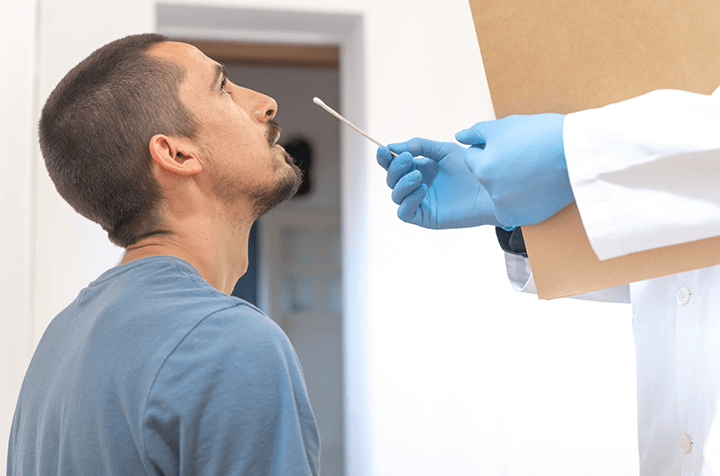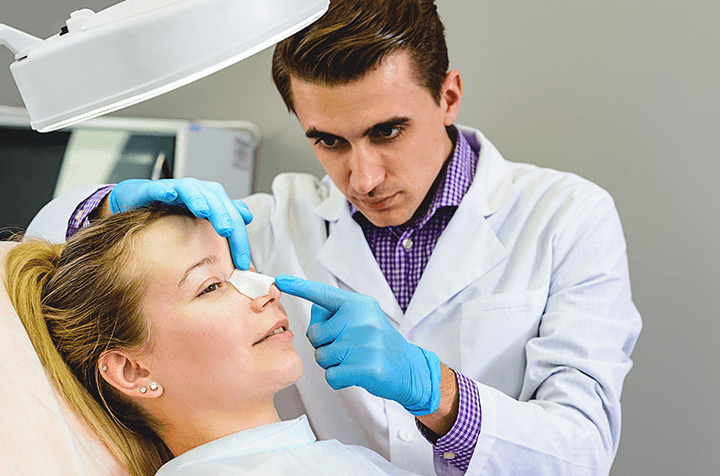You are not happy with the sagging appearance of your face? You had enough of the signs of aging, and you want to look younger and fresh? Then facelift is what you’re looking for!
Book your consultation
When you get older, gravity negatively affects your skin. Sagging, loss of elasticity, and wrinkles begin to appear on your face. Facelift, also known as rhytidectomy, is a surgical procedure performed to reduce the most visible signs of aging by removing excess fat, tightening muscles and redraping of the skin of your face and neck. A facelift is generally combined with other procedures such as eyelid lift and forehead lift.
Worldwide, more than a hundred thousand people have facelift operation each year. If you have a strong bone structure and still have some skin elasticity while having a facial sagging, you can be a candidate, too.
Facelift is a customized procedure tailored according to patients’ specific needs. Here you can find answers for different complaints.

Unfortunately, there are a lot of unfortunate examples. We really understand your concern. Selecting...

If you have a mild degree of jowling and sagging skin, you can be a good candidate for a mini facelift...

If you seek optimal correction to significant facial sagging, a traditional/standard facelift may be...

It is common a lot of people think that a facelift procedure involves any type of facial rejuvenation surgery...

If you only have a problem in your cheek area, then a mid-facelift procedure can be suitable for your...

The S-lift is one of the mini facelift techniques which helps to improve the appearance of mild to moderate...

A stem sell facelift, also known as a liquid facelift, is a nonsurgical facial rejuvenation procedure that uses...
Experience speaks for itself! Hear out what our patients have said:
At Clineca, we take everything seriously. We understand how important the results are for you. We care about your health and comfort as much as you do. From beginning to end, we inform you, guide you, serve you, and help you.

Surgeries are performed in prestigious fully equipped hospitals in which doctors from all specialties are present.

You will have an online consultation with your surgeon via video chat. After an online examination, and will help you to choose what's the best.

We cooperate with the surgeons who perform a limited number of surgeries each week to ensure the best results.

You can contact our agents 7 days and 24 hours for your questions and concerns, or only support. We'll be fully available for your service.

We provide you with special discounts in luxurious hotels in the vicinity of the hospital. Your comfort is very important to us.

We provide airport transfer and transportation between your hotel and the hospital before/after the surgery via VIP vehicles.

As Clineca, we provide you with patient accompaniment, who will visit you every day in your hotel room during the resting period.

The price includes fees of the surgeon, operating room, hospitalization, tests, medications and medical visits by a nurse.

The price includes hotel layover (including breakfast), and transportation between the airport, the hotel and the hospital.

Interpreter service, BBL pillow, neck pillow (rhinoplasty), eye mask, voltage converter and many others that will enhance your satisfaction.

Turkey is a leading player in medical tourism, and Istanbul, which is an extremely beautiful touristic city, is the plastic surgery capital of Turkey.
Clineca has a holistic approach. We believe that everything should be right for a satisfactory cosmetic surgery experience, including your days in Istanbul. We plan every detail of your journey.
After you fill the form, one of our agents will contact you. They will inform you about the whole experience, in detail. If requested, they will arrange an online consultation for you.
You'll have an online consultation with your surgeon via video chat. They will perform an online examination and help you to choose what the best approach to your case is.
We'll plan your whole journey including your surgery date and accommodation. We'll inform you about every need; from preparing your suitcase to advice before the procedure.
Our VIP transportation vehicle will be ready at the airport for you. We’ll drive you to the hospital and they'll get a blood and the C19 test. Then, we'll take you to your hotel.
We’ll take you from your hotel to the hospital. After your examination, the same day you’ll have the surgery. You will stay at the hospital 1-2 day(s), depending on the procedure.
After your stay at the hospital, we'll drive you to your hotel. A wellbeing assistant will visit you every day to inform you, to examine, and to provide medical care during the week.
We'll gladly and proudly show you around our beautiful city. We’ll be very happy to provide you with professional guidance in historical sightseeing, shopping and entertainment.
We’ll take you to 1-week follow-up. After your examination and removal of bandages if required, we’ll inform you about the recovery period. Then, we'll drive you to the airport.
During your recovery, we'll inform you, check on you, and answer your questions 24 hours and 7 days. We'll expect you to send photos periodically to follow your recovery period.

It is not hard to be eligible for a facelift procedure. If you are reading this, you are probably a candidate!
You may be a good candidate:
The outcomes of facelift can be analyzed in two main categories: aesthetical and psychological.
Facelift can address all kinds of aesthetical concerns, related to the signs of aging, about your face. A facelift procedure improves the most visible signs of aging. Through facelift, you look younger and fresher, you will have a more youthful appearance. Your face is rejuvenated by about five to ten years. You will get rid of sagging, unwanted lines, and wrinkles on the skin of your face.
The psychological outcomes of the procedure are as important as the physical ones. For most people, sagging or deformed appearance of the face is a big concern. If you are not happy with the appearance of your face, you can experience serious psychological distress, which can negatively affect your self-confidence and social life. After the procedure, you will have a more positive self-image. Your newly lifted youthful face will boost your self-confidence.

Facelift is a cosmetic surgery procedure performed to change the appearance of the face. It is a complex surgery customized according to needs and wishes of the patient.

First thing, you will receive anesthesia medications. Depending on the particular case, the surgery can be performed using either general anesthesia, or local anesthesia with sedation.
The details of the surgery depend on the patient’s needs and the surgeon’s approach. Our contracted surgeons are capable of performing several different facelift techniques. And, this surgery is a customized procedure. What’s suitable for you depends on your anatomical characteristics and your desired goals
Broadly; after the incisions are made, the skin is detached from the underlying tissues and muscles which allows your surgeon to reposition the deeper facial tissues, get rid of the jowls and form a firmer basis for the skin. Excess fat in the neck and face might be sculpted, removed, or redistributed. Right after that, the excess skin is removed, and the remaining skin is redraped over the newly repositioned facial tissues. Finally, the wound is stitched and closed.*1


Incision types can vary, and the differences depend on the extent of the incision and the degree of the lift necessary. There are typically three types of incisions:
Facelift surgery can be done by employing one of the 4 major techniques, which would be decided on your facial anatomy, your problems and desires as well as the surgeon’s preference. The complications and risks can be split into 2 as early and late complications, regarding when they present themselves.
Early Complications:
Late Complications:
After the surgery, your incisions might be covered with bandages to decrease swelling and bruising. A small drainage tube might be placed under the skin behind your ears. The day after surgery, these will be removed, and your surgeon will apply some antibiotic ointment to your incisions and cover your face with new bandages. 2-3 days after your facelift operation, you might be freed from bandages and wear an elasticized facial sling. You may experience some pain and discomfort within this period, but it can be eased with pain medication. Besides, you can apply cold compress to your face to ease pain and decrease swelling. About a week after surgery, your surgeon will remove your stitches and assess your healing rate. Depending on your healing process, you may need to take 2-3 weeks off work.
Swelling and bruising will gradually disappear and should be difficult to notice after about 1-2 weeks. Within two weeks, you will be able to return to your normal daily activities. After four to six weeks, you can return to strenuous exercises and demanding physical activities. 6-8 weeks after the surgery, the scars will start to fade. In addition, you will be more vulnerable to sunlight for several weeks, and you should wear a hat and apply sunscreen regularly. A few months after the surgery, your recovery will be completed. During your whole recovery period, your surgeon and Clineca will inform you and guide you.
A wellbeing assistant will visit you in your hotel room every day during the first week after the surgery. We will expect you to be in our clinic for your post-op examination 1 week after the surgery, before you leave Istanbul. We will still follow your recovery process while you are away. Clineca will provide you with complete support and inform you about everything you need to know during your recovery. We will be with you from your consultation to the very end of your recovery.

“Facelift procedure does miracles for suitable patients. With the help of advanced surgical techniques and easily combinable lifting procedures, we are able to work to ‘turn back the clock’, for our patients.”

During your online consultation, your surgeon will ask you questions about your medical history. It is of critical importance that you give your doctor every detail, from the conditions you might have to the operations you had in the past, to the medications and supplements you use, to minimize the risks the surgery could bring. They will also conduct a physical examination. Your surgeon will inform you about everything you need to know before the surgery. Clineca will provide you with complete guidance and support before your surgery. You will have a complete and detailed list of instructions.
Most important instructions include,


What you need to do after the surgery will be explained to you in detail by your surgeon and Clineca will provide you with all the support and guidance you need. Most important instructions include:

“Of course, there are non-surgical cosmetic procedures for the face. But the most effective treatment against the most of the marks of aging on the face is facelift surgery.”

We know you have many questions. Having realistic expectations and deciding to have a cosmetic surgery requires information. Here you can find answers to frequently asked questions about facelift surgery.
Facelift is a customized procedure tailored according to patients’ specific needs. Here you can find answers for different complaints.
1. Charafeddine, A., Drake, R., McBride, J., & Zins, J. E. (2019). Facelift. Clinics in Plastic Surgery. https://doi.org/doi:10.1016/j.cps.2019.05.001
2. Van Pham, T., & Truong, K. (2020). Short or Minimum Incision Deep Plane/Extended Deep Plane Facelift/Rhytidectomy. Facial plastic surgery : FPS, 36(4), 376–385. https://doi.org/10.1055/s-0040-1714118
3. Ahmed M Hashem, MD, Rafael A Couto, MD, Chris Surek, DO, Marco Swanson, MD, James E Zins, MD, FACS, Facelift Part II: Surgical Techniques and Complications, Aesthetic Surgery Journal, Volume 41, Issue 10, October 2021, Pages NP1276–NP1294. https://doi.org/10.1093/asj/sjab081
4. Brennan, D. (2021, April 12). What is a Seroma? WebMD. May 12, 2022. https://www.webmd.com/skin-problems-and-treatments/what-is-a-seroma